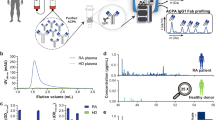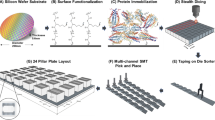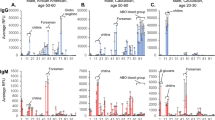Abstract
A hallmark of autoimmune diseases is the production of high titers of highly specific autoantibodies, which are routinely measured to guide clinical decision-making. Multiplex antigen microarrays are powerful tools that can provide profiles of the autoantibodies found in blood and other biological fluids. This high-throughput technology allows for rapid identification of antibody and antigen biomarker sets, which is sorely needed in the clinic to improve diagnosis, predictions of prognosis, and selection of targeted therapies. In this article we will describe the antigen microarray technologies that are currently available, and those that are in development. We highlight recent applications for antibody profiling, as well as the challenges that need to be faced before such technologies enter the clinic.
Key Points
-
Antigen arrays are available for rapid detection of multiple autoantibodies in microliter volumes of biological fluids
-
Multiplex antigen arrays are invaluable tools for identifying disease-specific autoantibody signatures
-
Autoantibody profiles can be followed over time as markers of disease remission or relapse
-
Novel antigens can be identified by testing reactivity of autoimmune sera to candidate antigens
-
Antigen-array technologies and the tools necessary for data interpretation are developing at an unprecedented rate
-
Individual autoantibody signatures can form the basis for patient-specific therapies
This is a preview of subscription content, access via your institution
Access options
Subscribe to this journal
Receive 12 print issues and online access
$209.00 per year
only $17.42 per issue
Buy this article
- Purchase on Springer Link
- Instant access to full article PDF
Prices may be subject to local taxes which are calculated during checkout


Similar content being viewed by others
References
von Mühlen CA and Tan EM (1995) Autoantibodies in the diagnosis of systemic rheumatic diseases. Semin Arthritis Rheum 24: 323–358
Anderson AC et al. (2000) High frequency of autoreactive myelin proteolipid protein-specific T cells in the periphery of naive mice: mechanisms of selection of the self-reactive repertoire. J Exp Med 191: 761–770
Altman JD et al. (1996) Phenotypic analysis of antigen-specific T lymphocytes. Science 274: 94–96
Steinman L (1996) A few autoreactive cells in an autoimmune infiltrate control a vast population of nonspecific cells: a tale of smart bombs and the infantry. Proc Natl Acad Sci USA 93: 2253–2256
Graham KL et al. (2004) High-throughput methods for measuring autoantibodies in systemic lupus erythematosus and other autoimmune diseases. Autoimmunity 37: 269–272
Schena M et al. (1995) Quantitative monitoring of gene expression patterns with a complementary DNA microarray. Science 270: 467–470
Mattoon D et al. (2005) Biomarker discovery using protein microarray technology platforms: antibody–antigen complex profiling. Expert Rev Proteomics 2: 879–889
Kersten B et al. (2005) Multiplex approaches in protein microarray technology. Expert Rev Proteomics 2: 499–510
Robinson WH et al. (2002) Autoantigen microarrays for multiplex characterization of autoantibody responses. Nat Med 8: 295–301
Hueber W et al. (2005) Antigen microarray profiling of autoantibodies in rheumatoid arthritis. Arthritis Rheum 52: 2645–2655
Zhen QL et al. (2005) Identification of autoantibody clusters that best predict lupus disease activity using glomerular proteome arrays. J Clin Invest 115: 3428–3349
Lueking A et al. (2005) Profiling of alopecia areata autoantigens based on protein microarray technology. Mol Cell Proteomics 4: 1382–1390
Robinson WH et al. (2003) Protein microarrays guide tolerizing DNA vaccine treatment of autoimmune encephalomyelitis. Nat Biotechnol 21: 1033–1039
Kanter JL et al. (2006) Lipid microarrays identify key mediators of autoimmune brain inflammation. Nat Med 12: 138–143
Quintana FJ et al. (2004) Functional immunomics: microarray analysis of IgG autoantibody repertoires predicts the future response of mice to induced diabetes. Proc Natl Acad Sci USA 101 (Suppl 2): 14615–14621
Hiller R et al. (2002) Microarrayed allergen molecules: diagnostic gatekeepers for allergy treatment. FASEB J 16: 414–416
Wiltshire S et al. (2000) Detection of multiple allergen-specific IgEs on microarrays by immunoassay with rolling circle amplification. Clin Chem 46: 1990–1993
Tong M et al. (2005) A multiplexed and miniaturized serological tuberculosis assay identifies antigens that discriminate maximally between TB and non-TB sera. J Immunol Methods 301: 154–163
Neuman de Vegvar HE et al. (2003) Microarray profiling of antibody responses against simian–human immunodeficiency virus: postchallenge convergence of reactivities independent of host histocompatibility type and vaccine regimen. J Virol 77: 11125–11138
Steller S et al. (2005) Bacterial protein microarrays for identification of new potential diagnostic markers for Neisseria meningitidis infections. Proteomics 5: 2048–2055
Thirumalapura NR et al. (2005) Lipopolysaccharide microarrays for the detection of antibodies. J Immunol Methods 298: 73–81
Davies DH et al. (2005) Profiling the humoral immune response to infection by using proteome microarrays: high-throughput vaccine and diagnostic antigen discovery. Proc Natl Acad Sci USA 102: 547–552
Li B et al. (2005) Protein microarray for profiling antibody responses to Yersinia pestis live vaccine. Infect Immun 73: 3734–3739
Davies DH et al. (2005) Vaccinia virus H3L envelope protein is a major target of neutralizing antibodies in humans and elicits protection against lethal challenge in mice. J Virol 79: 11724–11733
Wang D et al. (2002) Carbohydrate microarrays for the recognition of cross-reactive molecular markers of microbes and host cells. Nat Biotechnol 20: 275–281
Lawrie CH et al. (2006) Cancer-associated carbohydrate identification in Hodgkin's lymphoma by carbohydrate array profiling. Int J Cancer 118: 3161–3166
Chatterjee M et al. (2006) Diagnostic markers of ovarian cancer by high-throughput antigen cloning and detection on arrays. Cancer Res 66: 1181–1190
Joos TO et al. (2000) A microarray enzyme-linked immunosorbent assay for autoimmune diagnostics. Electrophoresis 21: 2641–2650
Horn S et al. (2006) Profiling humoral autoimmune repertoire of dilated cardiomyopathy (DCM) patients and development of a disease-associated protein chip. Proteomics 6: 605–613
Subramanian S et al. (2006) A Tlr7 translocation accelerates systemic autoimmunity in murine lupus. Proc Natl Acad Sci USA 103: 9970–9975
Kattah MG et al. (2006) A new two-color Fab labeling method for autoantigen protein microarrays. Nat Methods 3: 745–751
Sekine H et al. (2006) Role of MHC-linked genes in autoantigen selection and renal disease in a murine model of systemic lupus erythematosus. J Immunol 177: 7423–7434
Arbuckle MR et al. (1999) Shared early autoantibody recognition events in the development of anti-Sm B/B' in human lupus. Scand J Immunol 50: 447–455
Li N et al. (2003) The role of intramolecular epitope spreading in the pathogenesis of endemic pemphigus foliaceus (fogo selvagem). J Exp Med 197: 1501–1510
Nimmerjahn F and Ravetch JV (2005) Divergent immunoglobulin g subclass activity through selective Fc receptor binding. Science 310: 1510–1512
Graham KL et al. (2006) Autoantigen arrays for multiplex analysis of antibody isotypes. Proteomics 6: 5720–5724
Fontoura P et al. (2005) Antigen-specific therapies in multiple sclerosis: going beyond proteins and peptides. Int Rev Immunol 24: 415–446
Albani S and Prakken B (2006) T cell epitope-specific immune therapy for rheumatic diseases. Arthritis Rheum 54: 19–25
Fathman CG et al. (2005) An array of possibilities for the study of autoimmunity. Nature 435: 605–611
Uchida T et al. (2002) Application of a novel protein biochip technology for detection and identification of rheumatoid arthritis biomarkers in synovial fluid. J Proteome Res 1: 495–499
Robinson WH (2006) Antigen arrays for antibody profiling. Curr Opin Chem Biol 10: 67–72
Fritzler MJ (2006) Advances and applications of multiplexed diagnostic technologies in autoimmune diseases. Lupus 15: 422–427
Angenendt P (2005) Progress in protein and antibody microarray technology. Drug Discov Today 10: 503–511
Guilleaume B et al. (2005) Systematic comparison of surface coatings for protein microarrays. Proteomics 5: 4705–4712
Binder SR (2006) Autoantibody detection using multiplex technologies. Lupus 15: 412–421
Balboni I et al. (2006) Multiplexed protein array platforms for analysis of autoimmune diseases. Annu Rev Immunol 24: 391–418
Acknowledgements
We thank members of the laboratories of PJ Utz, William H Robinson and Larry Steinman for the development of some of the technologies described in this article. V Sharp was funded by an NIH grant. PJ Utz is the recipient of a Donald E and Delia B Baxter Foundation Career Development Award, and was supported by the Dana Foundation, the Floren Family Trust, the Northern California Chapter of the Arthritis Foundation, NIH grants, and a proteomics contract from the National Heart, Lung, and Blood Institute.
Author information
Authors and Affiliations
Corresponding author
Ethics declarations
Competing interests
PJ Utz states the following conflict of interest disclosures: that in the past 3 years he has served as a consultant at Centocor (Horsham, PA), Biogen Idec (Cambridge, MA), and Genentech, Inc (South San Francisco, CA), and Avanir, Inc (La Jolla, CA); he is a member of the Scientific Advisory Board of Monogram Biosciences (South San Francisco, CA) and XDx, Inc (South San Francisco, CA), and is a co-founder of and consultant to Bayhill Therapeutics (Palo Alto, CA).
V Sharp declared no competing interests.
Rights and permissions
About this article
Cite this article
Sharp, V., Utz, P. Technology Insight: can autoantibody profiling improve clinical practice?. Nat Rev Rheumatol 3, 96–103 (2007). https://doi.org/10.1038/ncprheum0404
Received:
Accepted:
Issue Date:
DOI: https://doi.org/10.1038/ncprheum0404
This article is cited by
-
New tools for classification and monitoring of autoimmune diseases
Nature Reviews Rheumatology (2012)
-
Biosensor approaches for the detection of autoantibodies in human serum
Bioanalytical Reviews (2012)
-
Myositis-specific autoantibodies: detection and clinical associations
Autoimmunity Highlights (2011)
-
Rapid serological detection of autoantibodies associated with Sjögren's syndrome
Journal of Translational Medicine (2009)
-
Protein microarrays for diagnostic assays
Analytical and Bioanalytical Chemistry (2009)



